Discharge Planning Report: Lewy Body Disease Patient Analysis
VerifiedAdded on 2021/04/17
|19
|4617
|45
Report
AI Summary
This report focuses on developing a comprehensive discharge plan for Mr. Angelo Davies, a patient diagnosed with Lewy Body Disease, hypertension, and hyperlipidemia. The plan considers his medical history, psychological and emotional needs, and social circumstances, including his desire to live at home near his daughter. The report emphasizes the importance of a multidisciplinary team, including nurses, social workers, occupational therapists, and pharmacists, to address his specific needs, such as medication management, dietary advice, and support for daily activities. The plan includes early planning, patient and family involvement, and clear communication among all parties. The report also highlights the roles of various healthcare professionals, the significance of nonverbal communication, and the need for ongoing support from family and community resources like wardens. It details the specific steps in discharge planning, including pre-admission planning, needs assessment, and coordination of care, ultimately aiming to facilitate a smooth transition from hospital to home while ensuring Mr. Davies's well-being and quality of life. The report also mentions the use of medications like Lisinopril and atorvastatin to manage his conditions, and the importance of diet and exercise. Finally the report also touches on the roles of speech and language therapists and the importance of communication.

Discharge Planning For A Long Term Condition Patient With Lewy Body Disease
DISCHARGE PLANNING FOR A LONG TERM CONDITION PATIENT WITH LEWY
BODY DISEASE
By Name
Course
Instructor
Institution
Location
Date
DISCHARGE PLANNING FOR A LONG TERM CONDITION PATIENT WITH LEWY
BODY DISEASE
By Name
Course
Instructor
Institution
Location
Date
Paraphrase This Document
Need a fresh take? Get an instant paraphrase of this document with our AI Paraphraser
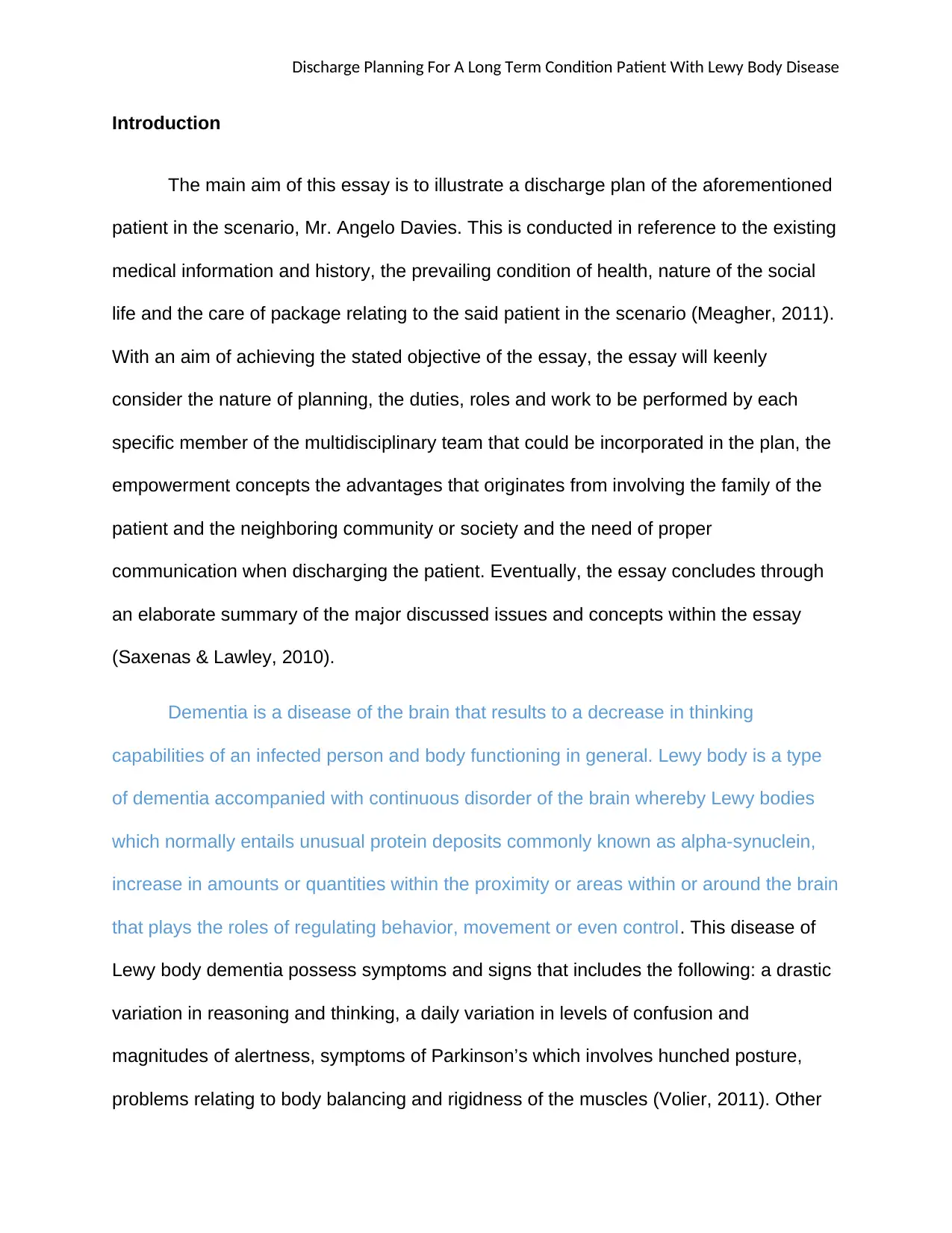
Discharge Planning For A Long Term Condition Patient With Lewy Body Disease
Introduction
The main aim of this essay is to illustrate a discharge plan of the aforementioned
patient in the scenario, Mr. Angelo Davies. This is conducted in reference to the existing
medical information and history, the prevailing condition of health, nature of the social
life and the care of package relating to the said patient in the scenario (Meagher, 2011).
With an aim of achieving the stated objective of the essay, the essay will keenly
consider the nature of planning, the duties, roles and work to be performed by each
specific member of the multidisciplinary team that could be incorporated in the plan, the
empowerment concepts the advantages that originates from involving the family of the
patient and the neighboring community or society and the need of proper
communication when discharging the patient. Eventually, the essay concludes through
an elaborate summary of the major discussed issues and concepts within the essay
(Saxenas & Lawley, 2010).
Dementia is a disease of the brain that results to a decrease in thinking
capabilities of an infected person and body functioning in general. Lewy body is a type
of dementia accompanied with continuous disorder of the brain whereby Lewy bodies
which normally entails unusual protein deposits commonly known as alpha-synuclein,
increase in amounts or quantities within the proximity or areas within or around the brain
that plays the roles of regulating behavior, movement or even control. This disease of
Lewy body dementia possess symptoms and signs that includes the following: a drastic
variation in reasoning and thinking, a daily variation in levels of confusion and
magnitudes of alertness, symptoms of Parkinson’s which involves hunched posture,
problems relating to body balancing and rigidness of the muscles (Volier, 2011). Other
Introduction
The main aim of this essay is to illustrate a discharge plan of the aforementioned
patient in the scenario, Mr. Angelo Davies. This is conducted in reference to the existing
medical information and history, the prevailing condition of health, nature of the social
life and the care of package relating to the said patient in the scenario (Meagher, 2011).
With an aim of achieving the stated objective of the essay, the essay will keenly
consider the nature of planning, the duties, roles and work to be performed by each
specific member of the multidisciplinary team that could be incorporated in the plan, the
empowerment concepts the advantages that originates from involving the family of the
patient and the neighboring community or society and the need of proper
communication when discharging the patient. Eventually, the essay concludes through
an elaborate summary of the major discussed issues and concepts within the essay
(Saxenas & Lawley, 2010).
Dementia is a disease of the brain that results to a decrease in thinking
capabilities of an infected person and body functioning in general. Lewy body is a type
of dementia accompanied with continuous disorder of the brain whereby Lewy bodies
which normally entails unusual protein deposits commonly known as alpha-synuclein,
increase in amounts or quantities within the proximity or areas within or around the brain
that plays the roles of regulating behavior, movement or even control. This disease of
Lewy body dementia possess symptoms and signs that includes the following: a drastic
variation in reasoning and thinking, a daily variation in levels of confusion and
magnitudes of alertness, symptoms of Parkinson’s which involves hunched posture,
problems relating to body balancing and rigidness of the muscles (Volier, 2011). Other
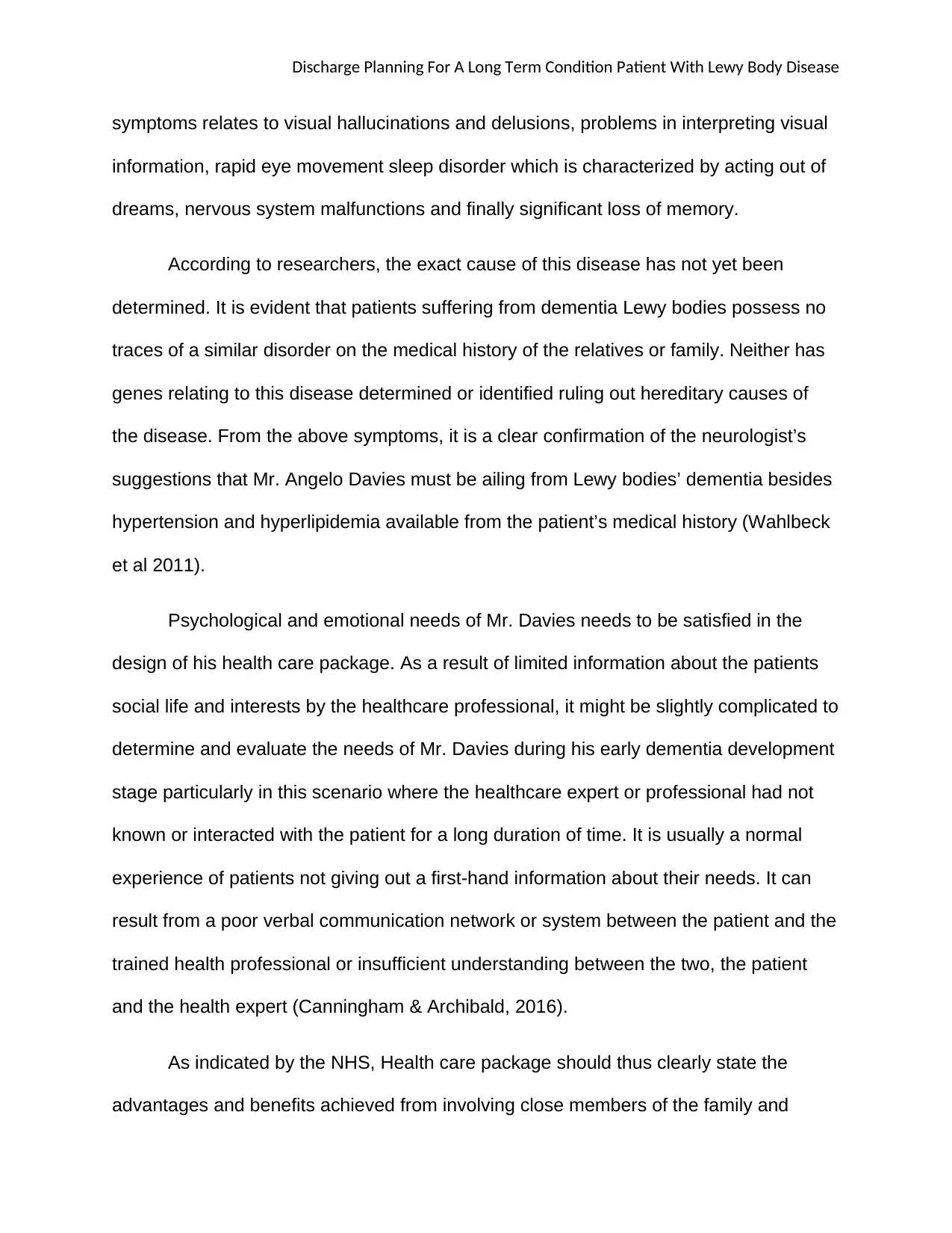
Discharge Planning For A Long Term Condition Patient With Lewy Body Disease
symptoms relates to visual hallucinations and delusions, problems in interpreting visual
information, rapid eye movement sleep disorder which is characterized by acting out of
dreams, nervous system malfunctions and finally significant loss of memory.
According to researchers, the exact cause of this disease has not yet been
determined. It is evident that patients suffering from dementia Lewy bodies possess no
traces of a similar disorder on the medical history of the relatives or family. Neither has
genes relating to this disease determined or identified ruling out hereditary causes of
the disease. From the above symptoms, it is a clear confirmation of the neurologist’s
suggestions that Mr. Angelo Davies must be ailing from Lewy bodies’ dementia besides
hypertension and hyperlipidemia available from the patient’s medical history (Wahlbeck
et al 2011).
Psychological and emotional needs of Mr. Davies needs to be satisfied in the
design of his health care package. As a result of limited information about the patients
social life and interests by the healthcare professional, it might be slightly complicated to
determine and evaluate the needs of Mr. Davies during his early dementia development
stage particularly in this scenario where the healthcare expert or professional had not
known or interacted with the patient for a long duration of time. It is usually a normal
experience of patients not giving out a first-hand information about their needs. It can
result from a poor verbal communication network or system between the patient and the
trained health professional or insufficient understanding between the two, the patient
and the health expert (Canningham & Archibald, 2016).
As indicated by the NHS, Health care package should thus clearly state the
advantages and benefits achieved from involving close members of the family and
symptoms relates to visual hallucinations and delusions, problems in interpreting visual
information, rapid eye movement sleep disorder which is characterized by acting out of
dreams, nervous system malfunctions and finally significant loss of memory.
According to researchers, the exact cause of this disease has not yet been
determined. It is evident that patients suffering from dementia Lewy bodies possess no
traces of a similar disorder on the medical history of the relatives or family. Neither has
genes relating to this disease determined or identified ruling out hereditary causes of
the disease. From the above symptoms, it is a clear confirmation of the neurologist’s
suggestions that Mr. Angelo Davies must be ailing from Lewy bodies’ dementia besides
hypertension and hyperlipidemia available from the patient’s medical history (Wahlbeck
et al 2011).
Psychological and emotional needs of Mr. Davies needs to be satisfied in the
design of his health care package. As a result of limited information about the patients
social life and interests by the healthcare professional, it might be slightly complicated to
determine and evaluate the needs of Mr. Davies during his early dementia development
stage particularly in this scenario where the healthcare expert or professional had not
known or interacted with the patient for a long duration of time. It is usually a normal
experience of patients not giving out a first-hand information about their needs. It can
result from a poor verbal communication network or system between the patient and the
trained health professional or insufficient understanding between the two, the patient
and the health expert (Canningham & Archibald, 2016).
As indicated by the NHS, Health care package should thus clearly state the
advantages and benefits achieved from involving close members of the family and
⊘ This is a preview!⊘
Do you want full access?
Subscribe today to unlock all pages.

Trusted by 1+ million students worldwide
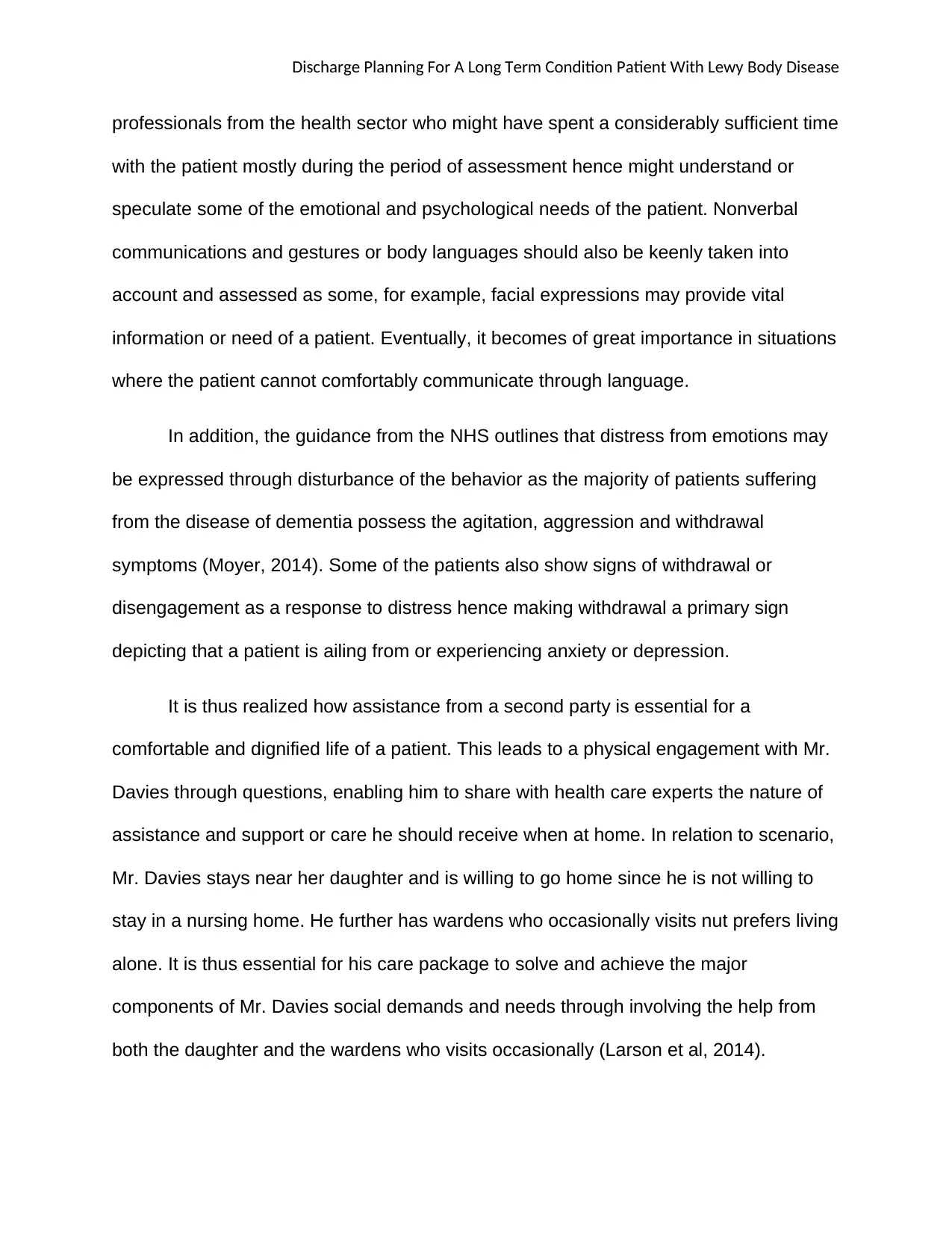
Discharge Planning For A Long Term Condition Patient With Lewy Body Disease
professionals from the health sector who might have spent a considerably sufficient time
with the patient mostly during the period of assessment hence might understand or
speculate some of the emotional and psychological needs of the patient. Nonverbal
communications and gestures or body languages should also be keenly taken into
account and assessed as some, for example, facial expressions may provide vital
information or need of a patient. Eventually, it becomes of great importance in situations
where the patient cannot comfortably communicate through language.
In addition, the guidance from the NHS outlines that distress from emotions may
be expressed through disturbance of the behavior as the majority of patients suffering
from the disease of dementia possess the agitation, aggression and withdrawal
symptoms (Moyer, 2014). Some of the patients also show signs of withdrawal or
disengagement as a response to distress hence making withdrawal a primary sign
depicting that a patient is ailing from or experiencing anxiety or depression.
It is thus realized how assistance from a second party is essential for a
comfortable and dignified life of a patient. This leads to a physical engagement with Mr.
Davies through questions, enabling him to share with health care experts the nature of
assistance and support or care he should receive when at home. In relation to scenario,
Mr. Davies stays near her daughter and is willing to go home since he is not willing to
stay in a nursing home. He further has wardens who occasionally visits nut prefers living
alone. It is thus essential for his care package to solve and achieve the major
components of Mr. Davies social demands and needs through involving the help from
both the daughter and the wardens who visits occasionally (Larson et al, 2014).
professionals from the health sector who might have spent a considerably sufficient time
with the patient mostly during the period of assessment hence might understand or
speculate some of the emotional and psychological needs of the patient. Nonverbal
communications and gestures or body languages should also be keenly taken into
account and assessed as some, for example, facial expressions may provide vital
information or need of a patient. Eventually, it becomes of great importance in situations
where the patient cannot comfortably communicate through language.
In addition, the guidance from the NHS outlines that distress from emotions may
be expressed through disturbance of the behavior as the majority of patients suffering
from the disease of dementia possess the agitation, aggression and withdrawal
symptoms (Moyer, 2014). Some of the patients also show signs of withdrawal or
disengagement as a response to distress hence making withdrawal a primary sign
depicting that a patient is ailing from or experiencing anxiety or depression.
It is thus realized how assistance from a second party is essential for a
comfortable and dignified life of a patient. This leads to a physical engagement with Mr.
Davies through questions, enabling him to share with health care experts the nature of
assistance and support or care he should receive when at home. In relation to scenario,
Mr. Davies stays near her daughter and is willing to go home since he is not willing to
stay in a nursing home. He further has wardens who occasionally visits nut prefers living
alone. It is thus essential for his care package to solve and achieve the major
components of Mr. Davies social demands and needs through involving the help from
both the daughter and the wardens who visits occasionally (Larson et al, 2014).
Paraphrase This Document
Need a fresh take? Get an instant paraphrase of this document with our AI Paraphraser
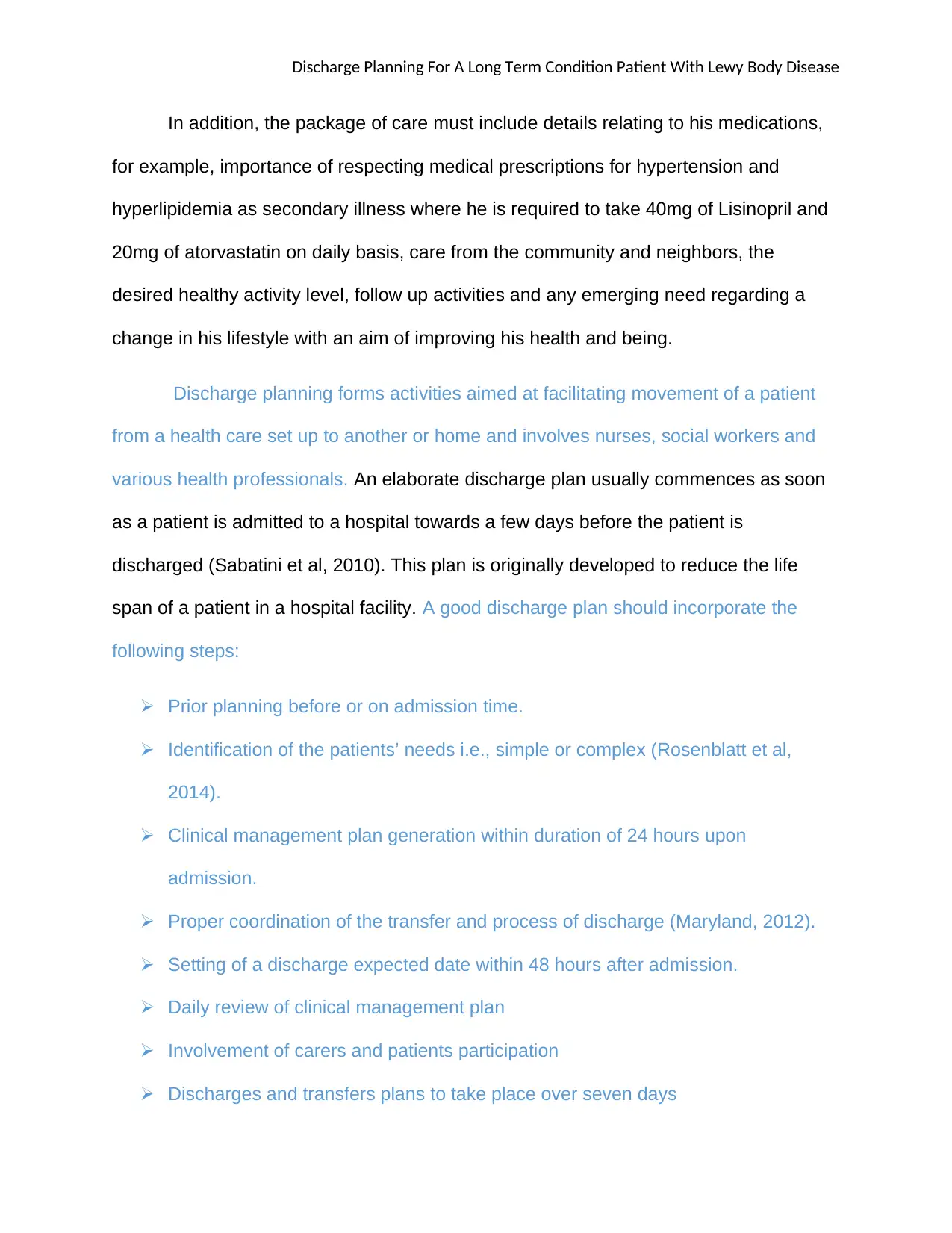
Discharge Planning For A Long Term Condition Patient With Lewy Body Disease
In addition, the package of care must include details relating to his medications,
for example, importance of respecting medical prescriptions for hypertension and
hyperlipidemia as secondary illness where he is required to take 40mg of Lisinopril and
20mg of atorvastatin on daily basis, care from the community and neighbors, the
desired healthy activity level, follow up activities and any emerging need regarding a
change in his lifestyle with an aim of improving his health and being.
Discharge planning forms activities aimed at facilitating movement of a patient
from a health care set up to another or home and involves nurses, social workers and
various health professionals. An elaborate discharge plan usually commences as soon
as a patient is admitted to a hospital towards a few days before the patient is
discharged (Sabatini et al, 2010). This plan is originally developed to reduce the life
span of a patient in a hospital facility. A good discharge plan should incorporate the
following steps:
Prior planning before or on admission time.
Identification of the patients’ needs i.e., simple or complex (Rosenblatt et al,
2014).
Clinical management plan generation within duration of 24 hours upon
admission.
Proper coordination of the transfer and process of discharge (Maryland, 2012).
Setting of a discharge expected date within 48 hours after admission.
Daily review of clinical management plan
Involvement of carers and patients participation
Discharges and transfers plans to take place over seven days
In addition, the package of care must include details relating to his medications,
for example, importance of respecting medical prescriptions for hypertension and
hyperlipidemia as secondary illness where he is required to take 40mg of Lisinopril and
20mg of atorvastatin on daily basis, care from the community and neighbors, the
desired healthy activity level, follow up activities and any emerging need regarding a
change in his lifestyle with an aim of improving his health and being.
Discharge planning forms activities aimed at facilitating movement of a patient
from a health care set up to another or home and involves nurses, social workers and
various health professionals. An elaborate discharge plan usually commences as soon
as a patient is admitted to a hospital towards a few days before the patient is
discharged (Sabatini et al, 2010). This plan is originally developed to reduce the life
span of a patient in a hospital facility. A good discharge plan should incorporate the
following steps:
Prior planning before or on admission time.
Identification of the patients’ needs i.e., simple or complex (Rosenblatt et al,
2014).
Clinical management plan generation within duration of 24 hours upon
admission.
Proper coordination of the transfer and process of discharge (Maryland, 2012).
Setting of a discharge expected date within 48 hours after admission.
Daily review of clinical management plan
Involvement of carers and patients participation
Discharges and transfers plans to take place over seven days
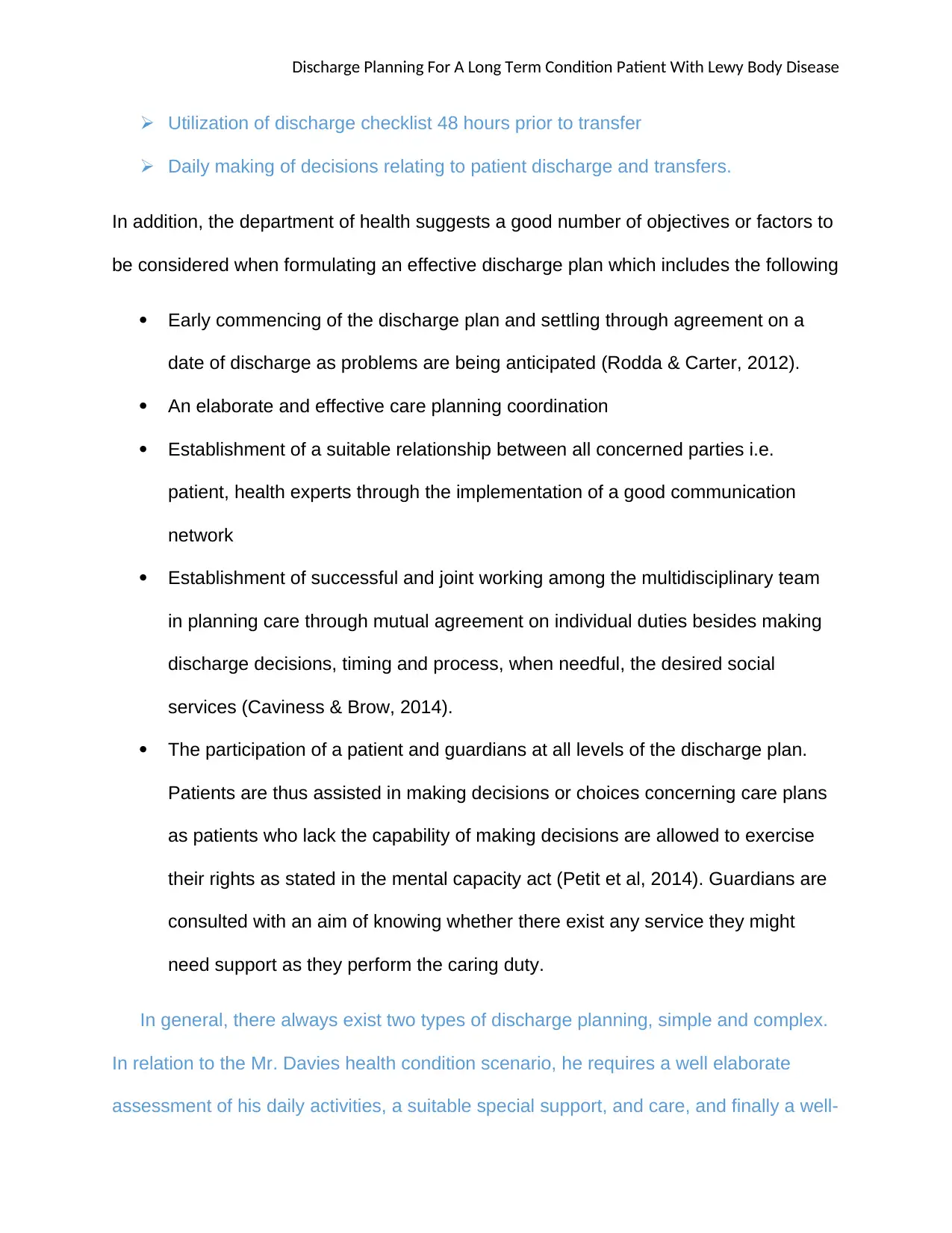
Discharge Planning For A Long Term Condition Patient With Lewy Body Disease
Utilization of discharge checklist 48 hours prior to transfer
Daily making of decisions relating to patient discharge and transfers.
In addition, the department of health suggests a good number of objectives or factors to
be considered when formulating an effective discharge plan which includes the following
Early commencing of the discharge plan and settling through agreement on a
date of discharge as problems are being anticipated (Rodda & Carter, 2012).
An elaborate and effective care planning coordination
Establishment of a suitable relationship between all concerned parties i.e.
patient, health experts through the implementation of a good communication
network
Establishment of successful and joint working among the multidisciplinary team
in planning care through mutual agreement on individual duties besides making
discharge decisions, timing and process, when needful, the desired social
services (Caviness & Brow, 2014).
The participation of a patient and guardians at all levels of the discharge plan.
Patients are thus assisted in making decisions or choices concerning care plans
as patients who lack the capability of making decisions are allowed to exercise
their rights as stated in the mental capacity act (Petit et al, 2014). Guardians are
consulted with an aim of knowing whether there exist any service they might
need support as they perform the caring duty.
In general, there always exist two types of discharge planning, simple and complex.
In relation to the Mr. Davies health condition scenario, he requires a well elaborate
assessment of his daily activities, a suitable special support, and care, and finally a well-
Utilization of discharge checklist 48 hours prior to transfer
Daily making of decisions relating to patient discharge and transfers.
In addition, the department of health suggests a good number of objectives or factors to
be considered when formulating an effective discharge plan which includes the following
Early commencing of the discharge plan and settling through agreement on a
date of discharge as problems are being anticipated (Rodda & Carter, 2012).
An elaborate and effective care planning coordination
Establishment of a suitable relationship between all concerned parties i.e.
patient, health experts through the implementation of a good communication
network
Establishment of successful and joint working among the multidisciplinary team
in planning care through mutual agreement on individual duties besides making
discharge decisions, timing and process, when needful, the desired social
services (Caviness & Brow, 2014).
The participation of a patient and guardians at all levels of the discharge plan.
Patients are thus assisted in making decisions or choices concerning care plans
as patients who lack the capability of making decisions are allowed to exercise
their rights as stated in the mental capacity act (Petit et al, 2014). Guardians are
consulted with an aim of knowing whether there exist any service they might
need support as they perform the caring duty.
In general, there always exist two types of discharge planning, simple and complex.
In relation to the Mr. Davies health condition scenario, he requires a well elaborate
assessment of his daily activities, a suitable special support, and care, and finally a well-
⊘ This is a preview!⊘
Do you want full access?
Subscribe today to unlock all pages.

Trusted by 1+ million students worldwide
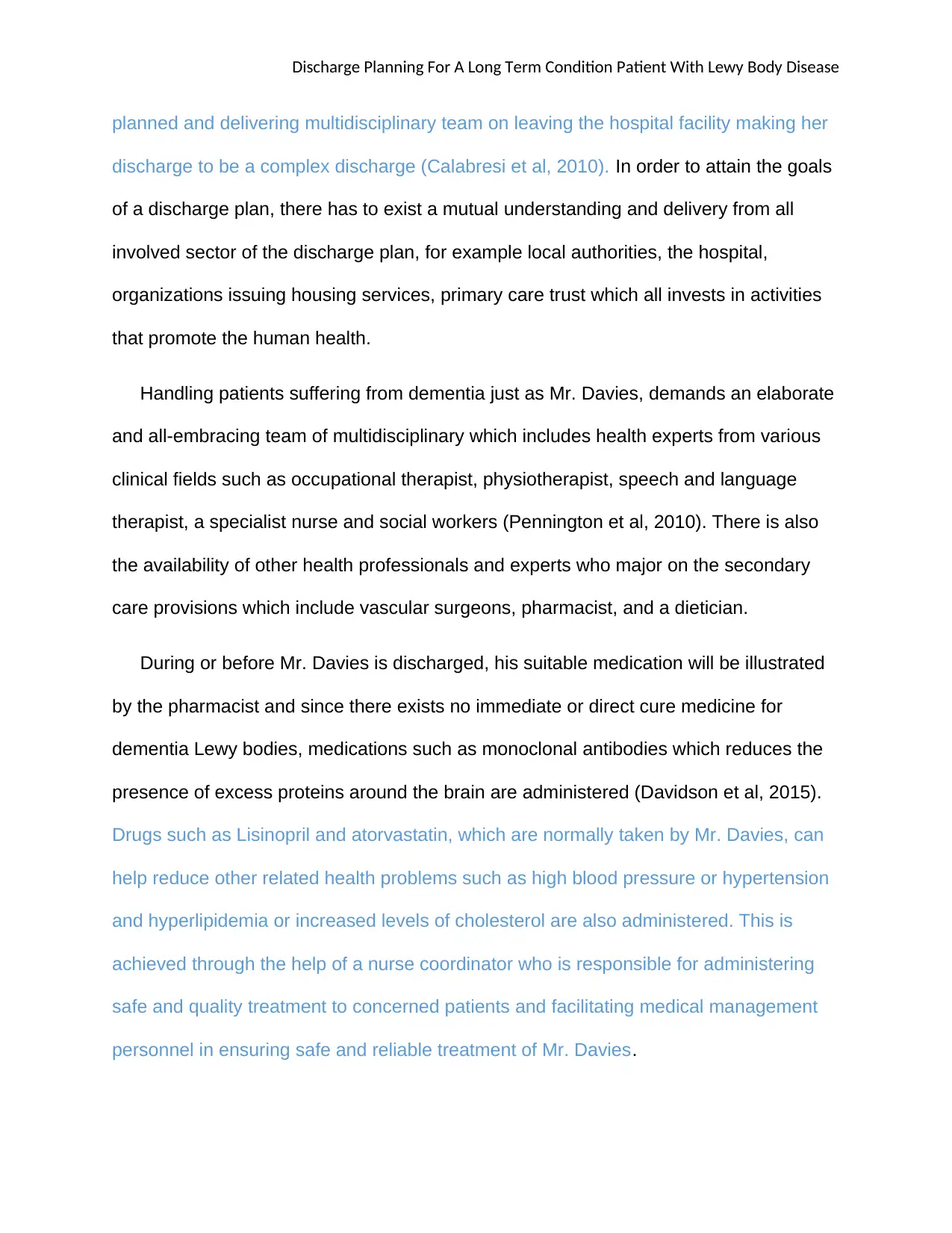
Discharge Planning For A Long Term Condition Patient With Lewy Body Disease
planned and delivering multidisciplinary team on leaving the hospital facility making her
discharge to be a complex discharge (Calabresi et al, 2010). In order to attain the goals
of a discharge plan, there has to exist a mutual understanding and delivery from all
involved sector of the discharge plan, for example local authorities, the hospital,
organizations issuing housing services, primary care trust which all invests in activities
that promote the human health.
Handling patients suffering from dementia just as Mr. Davies, demands an elaborate
and all-embracing team of multidisciplinary which includes health experts from various
clinical fields such as occupational therapist, physiotherapist, speech and language
therapist, a specialist nurse and social workers (Pennington et al, 2010). There is also
the availability of other health professionals and experts who major on the secondary
care provisions which include vascular surgeons, pharmacist, and a dietician.
During or before Mr. Davies is discharged, his suitable medication will be illustrated
by the pharmacist and since there exists no immediate or direct cure medicine for
dementia Lewy bodies, medications such as monoclonal antibodies which reduces the
presence of excess proteins around the brain are administered (Davidson et al, 2015).
Drugs such as Lisinopril and atorvastatin, which are normally taken by Mr. Davies, can
help reduce other related health problems such as high blood pressure or hypertension
and hyperlipidemia or increased levels of cholesterol are also administered. This is
achieved through the help of a nurse coordinator who is responsible for administering
safe and quality treatment to concerned patients and facilitating medical management
personnel in ensuring safe and reliable treatment of Mr. Davies.
planned and delivering multidisciplinary team on leaving the hospital facility making her
discharge to be a complex discharge (Calabresi et al, 2010). In order to attain the goals
of a discharge plan, there has to exist a mutual understanding and delivery from all
involved sector of the discharge plan, for example local authorities, the hospital,
organizations issuing housing services, primary care trust which all invests in activities
that promote the human health.
Handling patients suffering from dementia just as Mr. Davies, demands an elaborate
and all-embracing team of multidisciplinary which includes health experts from various
clinical fields such as occupational therapist, physiotherapist, speech and language
therapist, a specialist nurse and social workers (Pennington et al, 2010). There is also
the availability of other health professionals and experts who major on the secondary
care provisions which include vascular surgeons, pharmacist, and a dietician.
During or before Mr. Davies is discharged, his suitable medication will be illustrated
by the pharmacist and since there exists no immediate or direct cure medicine for
dementia Lewy bodies, medications such as monoclonal antibodies which reduces the
presence of excess proteins around the brain are administered (Davidson et al, 2015).
Drugs such as Lisinopril and atorvastatin, which are normally taken by Mr. Davies, can
help reduce other related health problems such as high blood pressure or hypertension
and hyperlipidemia or increased levels of cholesterol are also administered. This is
achieved through the help of a nurse coordinator who is responsible for administering
safe and quality treatment to concerned patients and facilitating medical management
personnel in ensuring safe and reliable treatment of Mr. Davies.
Paraphrase This Document
Need a fresh take? Get an instant paraphrase of this document with our AI Paraphraser
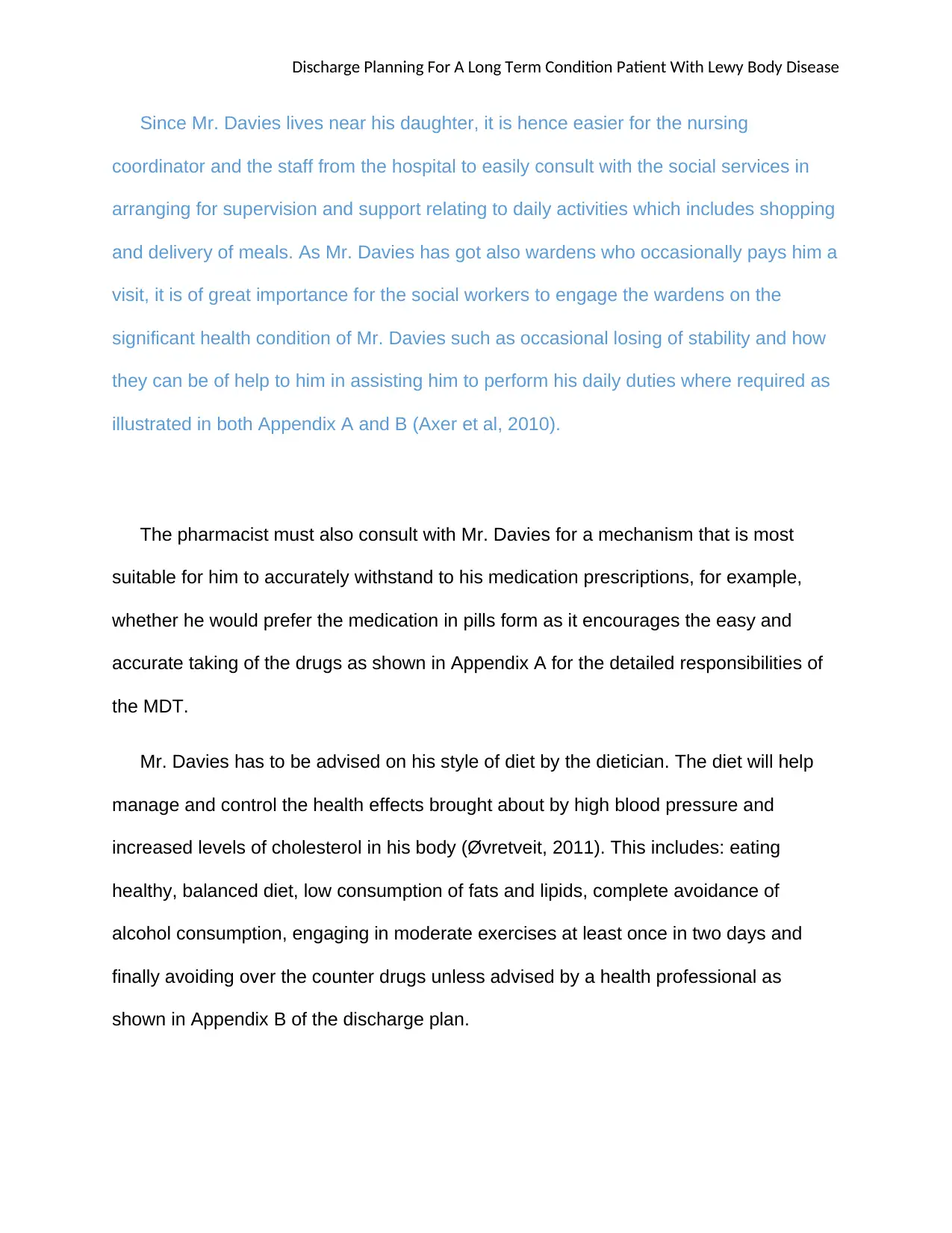
Discharge Planning For A Long Term Condition Patient With Lewy Body Disease
Since Mr. Davies lives near his daughter, it is hence easier for the nursing
coordinator and the staff from the hospital to easily consult with the social services in
arranging for supervision and support relating to daily activities which includes shopping
and delivery of meals. As Mr. Davies has got also wardens who occasionally pays him a
visit, it is of great importance for the social workers to engage the wardens on the
significant health condition of Mr. Davies such as occasional losing of stability and how
they can be of help to him in assisting him to perform his daily duties where required as
illustrated in both Appendix A and B (Axer et al, 2010).
The pharmacist must also consult with Mr. Davies for a mechanism that is most
suitable for him to accurately withstand to his medication prescriptions, for example,
whether he would prefer the medication in pills form as it encourages the easy and
accurate taking of the drugs as shown in Appendix A for the detailed responsibilities of
the MDT.
Mr. Davies has to be advised on his style of diet by the dietician. The diet will help
manage and control the health effects brought about by high blood pressure and
increased levels of cholesterol in his body (Øvretveit, 2011). This includes: eating
healthy, balanced diet, low consumption of fats and lipids, complete avoidance of
alcohol consumption, engaging in moderate exercises at least once in two days and
finally avoiding over the counter drugs unless advised by a health professional as
shown in Appendix B of the discharge plan.
Since Mr. Davies lives near his daughter, it is hence easier for the nursing
coordinator and the staff from the hospital to easily consult with the social services in
arranging for supervision and support relating to daily activities which includes shopping
and delivery of meals. As Mr. Davies has got also wardens who occasionally pays him a
visit, it is of great importance for the social workers to engage the wardens on the
significant health condition of Mr. Davies such as occasional losing of stability and how
they can be of help to him in assisting him to perform his daily duties where required as
illustrated in both Appendix A and B (Axer et al, 2010).
The pharmacist must also consult with Mr. Davies for a mechanism that is most
suitable for him to accurately withstand to his medication prescriptions, for example,
whether he would prefer the medication in pills form as it encourages the easy and
accurate taking of the drugs as shown in Appendix A for the detailed responsibilities of
the MDT.
Mr. Davies has to be advised on his style of diet by the dietician. The diet will help
manage and control the health effects brought about by high blood pressure and
increased levels of cholesterol in his body (Øvretveit, 2011). This includes: eating
healthy, balanced diet, low consumption of fats and lipids, complete avoidance of
alcohol consumption, engaging in moderate exercises at least once in two days and
finally avoiding over the counter drugs unless advised by a health professional as
shown in Appendix B of the discharge plan.
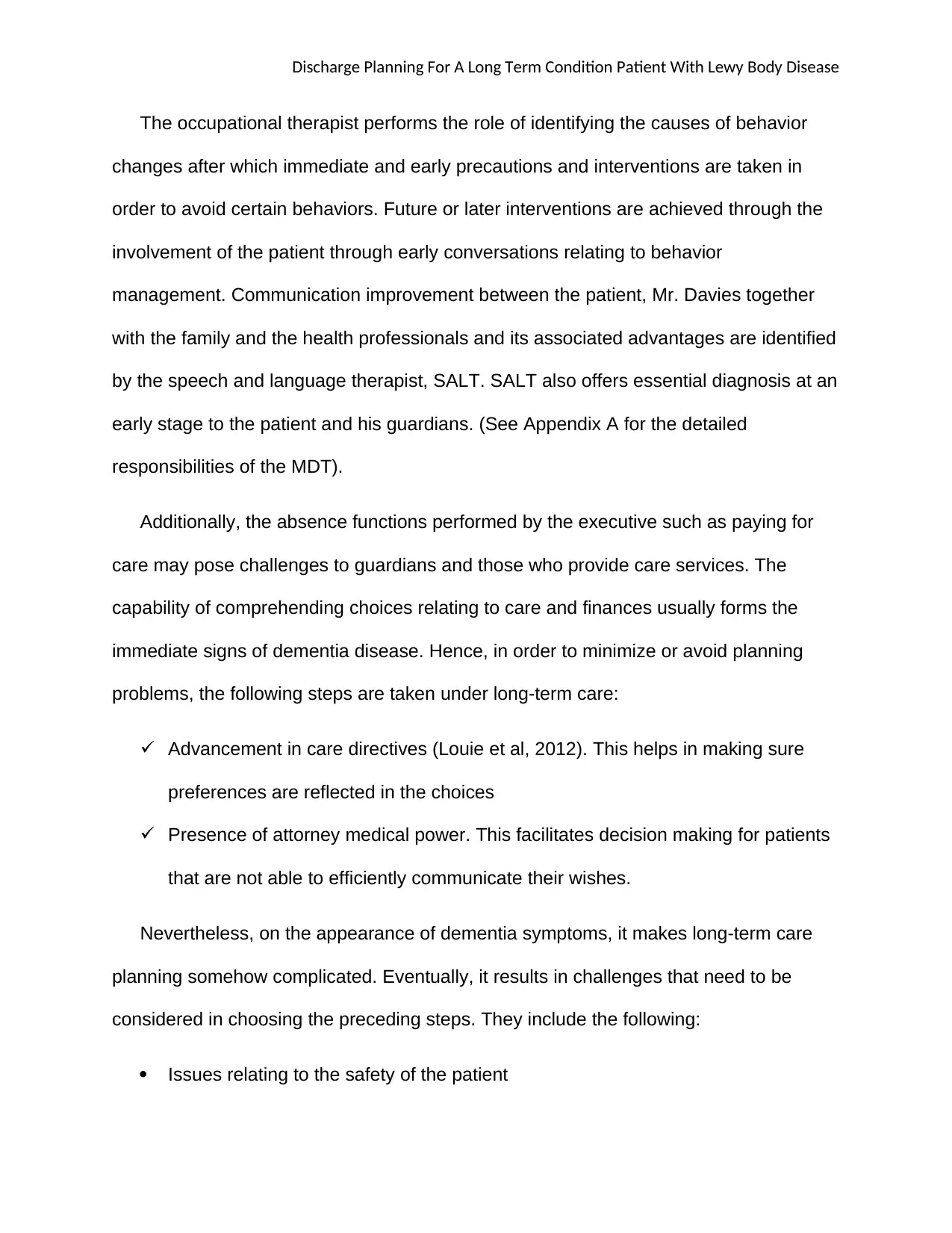
Discharge Planning For A Long Term Condition Patient With Lewy Body Disease
The occupational therapist performs the role of identifying the causes of behavior
changes after which immediate and early precautions and interventions are taken in
order to avoid certain behaviors. Future or later interventions are achieved through the
involvement of the patient through early conversations relating to behavior
management. Communication improvement between the patient, Mr. Davies together
with the family and the health professionals and its associated advantages are identified
by the speech and language therapist, SALT. SALT also offers essential diagnosis at an
early stage to the patient and his guardians. (See Appendix A for the detailed
responsibilities of the MDT).
Additionally, the absence functions performed by the executive such as paying for
care may pose challenges to guardians and those who provide care services. The
capability of comprehending choices relating to care and finances usually forms the
immediate signs of dementia disease. Hence, in order to minimize or avoid planning
problems, the following steps are taken under long-term care:
Advancement in care directives (Louie et al, 2012). This helps in making sure
preferences are reflected in the choices
Presence of attorney medical power. This facilitates decision making for patients
that are not able to efficiently communicate their wishes.
Nevertheless, on the appearance of dementia symptoms, it makes long-term care
planning somehow complicated. Eventually, it results in challenges that need to be
considered in choosing the preceding steps. They include the following:
Issues relating to the safety of the patient
The occupational therapist performs the role of identifying the causes of behavior
changes after which immediate and early precautions and interventions are taken in
order to avoid certain behaviors. Future or later interventions are achieved through the
involvement of the patient through early conversations relating to behavior
management. Communication improvement between the patient, Mr. Davies together
with the family and the health professionals and its associated advantages are identified
by the speech and language therapist, SALT. SALT also offers essential diagnosis at an
early stage to the patient and his guardians. (See Appendix A for the detailed
responsibilities of the MDT).
Additionally, the absence functions performed by the executive such as paying for
care may pose challenges to guardians and those who provide care services. The
capability of comprehending choices relating to care and finances usually forms the
immediate signs of dementia disease. Hence, in order to minimize or avoid planning
problems, the following steps are taken under long-term care:
Advancement in care directives (Louie et al, 2012). This helps in making sure
preferences are reflected in the choices
Presence of attorney medical power. This facilitates decision making for patients
that are not able to efficiently communicate their wishes.
Nevertheless, on the appearance of dementia symptoms, it makes long-term care
planning somehow complicated. Eventually, it results in challenges that need to be
considered in choosing the preceding steps. They include the following:
Issues relating to the safety of the patient
⊘ This is a preview!⊘
Do you want full access?
Subscribe today to unlock all pages.

Trusted by 1+ million students worldwide
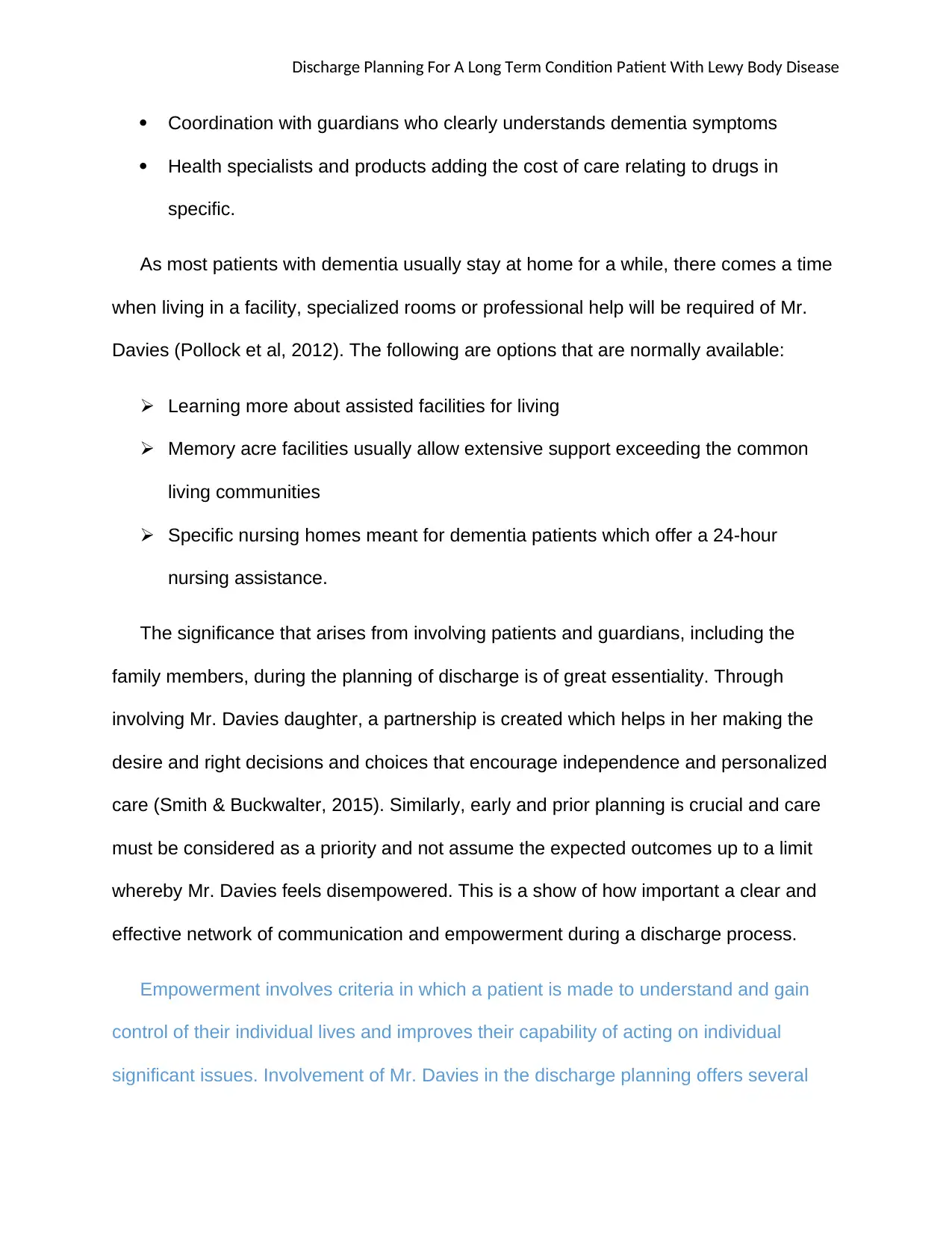
Discharge Planning For A Long Term Condition Patient With Lewy Body Disease
Coordination with guardians who clearly understands dementia symptoms
Health specialists and products adding the cost of care relating to drugs in
specific.
As most patients with dementia usually stay at home for a while, there comes a time
when living in a facility, specialized rooms or professional help will be required of Mr.
Davies (Pollock et al, 2012). The following are options that are normally available:
Learning more about assisted facilities for living
Memory acre facilities usually allow extensive support exceeding the common
living communities
Specific nursing homes meant for dementia patients which offer a 24-hour
nursing assistance.
The significance that arises from involving patients and guardians, including the
family members, during the planning of discharge is of great essentiality. Through
involving Mr. Davies daughter, a partnership is created which helps in her making the
desire and right decisions and choices that encourage independence and personalized
care (Smith & Buckwalter, 2015). Similarly, early and prior planning is crucial and care
must be considered as a priority and not assume the expected outcomes up to a limit
whereby Mr. Davies feels disempowered. This is a show of how important a clear and
effective network of communication and empowerment during a discharge process.
Empowerment involves criteria in which a patient is made to understand and gain
control of their individual lives and improves their capability of acting on individual
significant issues. Involvement of Mr. Davies in the discharge planning offers several
Coordination with guardians who clearly understands dementia symptoms
Health specialists and products adding the cost of care relating to drugs in
specific.
As most patients with dementia usually stay at home for a while, there comes a time
when living in a facility, specialized rooms or professional help will be required of Mr.
Davies (Pollock et al, 2012). The following are options that are normally available:
Learning more about assisted facilities for living
Memory acre facilities usually allow extensive support exceeding the common
living communities
Specific nursing homes meant for dementia patients which offer a 24-hour
nursing assistance.
The significance that arises from involving patients and guardians, including the
family members, during the planning of discharge is of great essentiality. Through
involving Mr. Davies daughter, a partnership is created which helps in her making the
desire and right decisions and choices that encourage independence and personalized
care (Smith & Buckwalter, 2015). Similarly, early and prior planning is crucial and care
must be considered as a priority and not assume the expected outcomes up to a limit
whereby Mr. Davies feels disempowered. This is a show of how important a clear and
effective network of communication and empowerment during a discharge process.
Empowerment involves criteria in which a patient is made to understand and gain
control of their individual lives and improves their capability of acting on individual
significant issues. Involvement of Mr. Davies in the discharge planning offers several
Paraphrase This Document
Need a fresh take? Get an instant paraphrase of this document with our AI Paraphraser
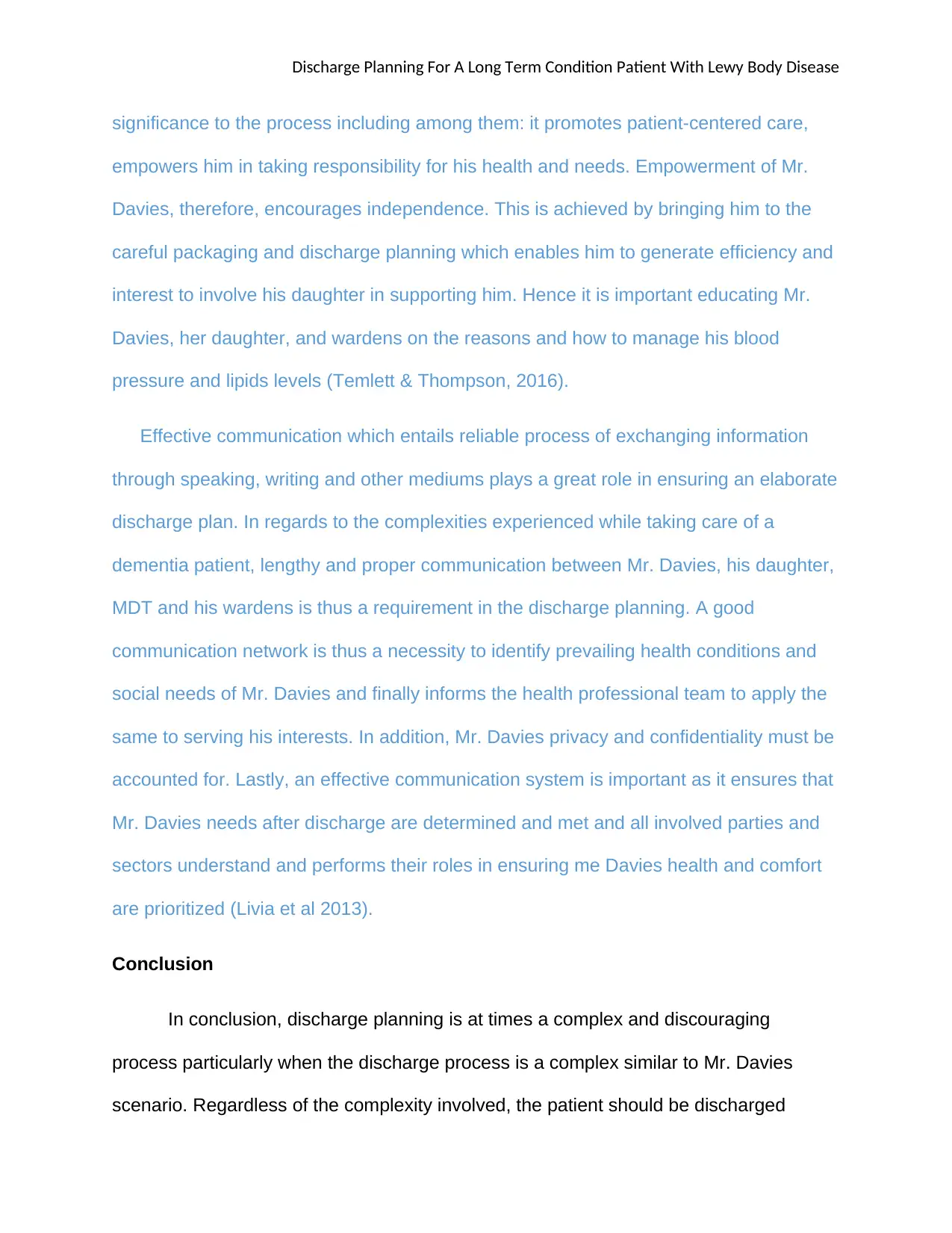
Discharge Planning For A Long Term Condition Patient With Lewy Body Disease
significance to the process including among them: it promotes patient-centered care,
empowers him in taking responsibility for his health and needs. Empowerment of Mr.
Davies, therefore, encourages independence. This is achieved by bringing him to the
careful packaging and discharge planning which enables him to generate efficiency and
interest to involve his daughter in supporting him. Hence it is important educating Mr.
Davies, her daughter, and wardens on the reasons and how to manage his blood
pressure and lipids levels (Temlett & Thompson, 2016).
Effective communication which entails reliable process of exchanging information
through speaking, writing and other mediums plays a great role in ensuring an elaborate
discharge plan. In regards to the complexities experienced while taking care of a
dementia patient, lengthy and proper communication between Mr. Davies, his daughter,
MDT and his wardens is thus a requirement in the discharge planning. A good
communication network is thus a necessity to identify prevailing health conditions and
social needs of Mr. Davies and finally informs the health professional team to apply the
same to serving his interests. In addition, Mr. Davies privacy and confidentiality must be
accounted for. Lastly, an effective communication system is important as it ensures that
Mr. Davies needs after discharge are determined and met and all involved parties and
sectors understand and performs their roles in ensuring me Davies health and comfort
are prioritized (Livia et al 2013).
Conclusion
In conclusion, discharge planning is at times a complex and discouraging
process particularly when the discharge process is a complex similar to Mr. Davies
scenario. Regardless of the complexity involved, the patient should be discharged
significance to the process including among them: it promotes patient-centered care,
empowers him in taking responsibility for his health and needs. Empowerment of Mr.
Davies, therefore, encourages independence. This is achieved by bringing him to the
careful packaging and discharge planning which enables him to generate efficiency and
interest to involve his daughter in supporting him. Hence it is important educating Mr.
Davies, her daughter, and wardens on the reasons and how to manage his blood
pressure and lipids levels (Temlett & Thompson, 2016).
Effective communication which entails reliable process of exchanging information
through speaking, writing and other mediums plays a great role in ensuring an elaborate
discharge plan. In regards to the complexities experienced while taking care of a
dementia patient, lengthy and proper communication between Mr. Davies, his daughter,
MDT and his wardens is thus a requirement in the discharge planning. A good
communication network is thus a necessity to identify prevailing health conditions and
social needs of Mr. Davies and finally informs the health professional team to apply the
same to serving his interests. In addition, Mr. Davies privacy and confidentiality must be
accounted for. Lastly, an effective communication system is important as it ensures that
Mr. Davies needs after discharge are determined and met and all involved parties and
sectors understand and performs their roles in ensuring me Davies health and comfort
are prioritized (Livia et al 2013).
Conclusion
In conclusion, discharge planning is at times a complex and discouraging
process particularly when the discharge process is a complex similar to Mr. Davies
scenario. Regardless of the complexity involved, the patient should be discharged
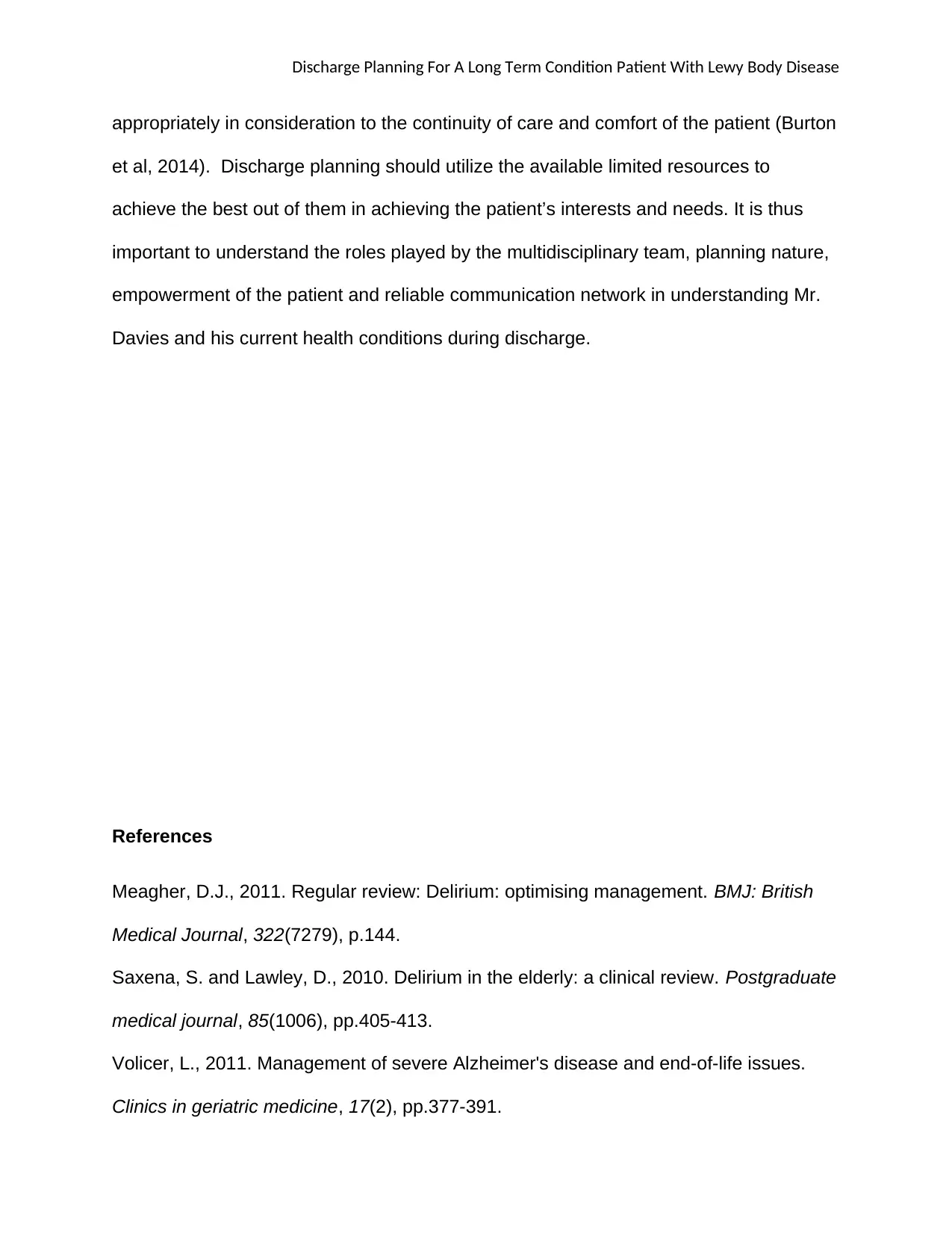
Discharge Planning For A Long Term Condition Patient With Lewy Body Disease
appropriately in consideration to the continuity of care and comfort of the patient (Burton
et al, 2014). Discharge planning should utilize the available limited resources to
achieve the best out of them in achieving the patient’s interests and needs. It is thus
important to understand the roles played by the multidisciplinary team, planning nature,
empowerment of the patient and reliable communication network in understanding Mr.
Davies and his current health conditions during discharge.
References
Meagher, D.J., 2011. Regular review: Delirium: optimising management. BMJ: British
Medical Journal, 322(7279), p.144.
Saxena, S. and Lawley, D., 2010. Delirium in the elderly: a clinical review. Postgraduate
medical journal, 85(1006), pp.405-413.
Volicer, L., 2011. Management of severe Alzheimer's disease and end-of-life issues.
Clinics in geriatric medicine, 17(2), pp.377-391.
appropriately in consideration to the continuity of care and comfort of the patient (Burton
et al, 2014). Discharge planning should utilize the available limited resources to
achieve the best out of them in achieving the patient’s interests and needs. It is thus
important to understand the roles played by the multidisciplinary team, planning nature,
empowerment of the patient and reliable communication network in understanding Mr.
Davies and his current health conditions during discharge.
References
Meagher, D.J., 2011. Regular review: Delirium: optimising management. BMJ: British
Medical Journal, 322(7279), p.144.
Saxena, S. and Lawley, D., 2010. Delirium in the elderly: a clinical review. Postgraduate
medical journal, 85(1006), pp.405-413.
Volicer, L., 2011. Management of severe Alzheimer's disease and end-of-life issues.
Clinics in geriatric medicine, 17(2), pp.377-391.
⊘ This is a preview!⊘
Do you want full access?
Subscribe today to unlock all pages.

Trusted by 1+ million students worldwide
1 out of 19
Related Documents
Your All-in-One AI-Powered Toolkit for Academic Success.
+13062052269
info@desklib.com
Available 24*7 on WhatsApp / Email
![[object Object]](/_next/static/media/star-bottom.7253800d.svg)
Unlock your academic potential
Copyright © 2020–2025 A2Z Services. All Rights Reserved. Developed and managed by ZUCOL.





